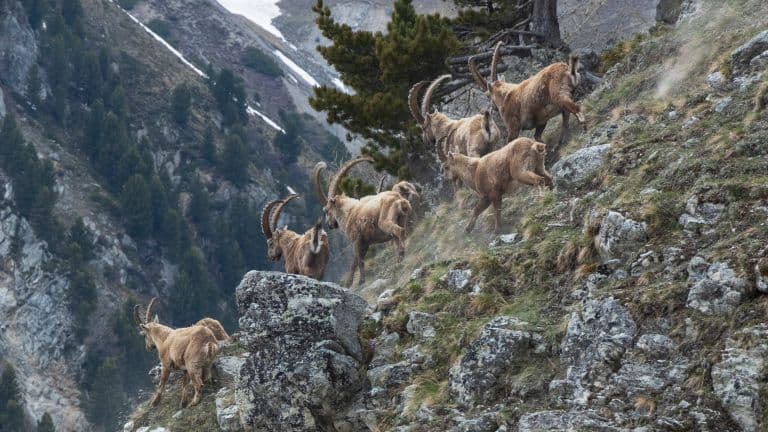If you're a fan of arts, crafts and wildlife, then low poly Ibex Papercraft is a fantastic way to blend your passion for animals with your love for crafting. Ibexes are majestic creatures known for their striking horns and mountain-dwelling habits. This paper model capture their essence in a geometric and minimalist style, making them both aesthetically pleasing and accessible for all skill levels.
In the following sections, Paper Iconic will provide you with free download links to low-poly Ibex papercraft and interesting facts about them. By the end of this journey, you'll have a unique piece of art that you can proudly display and share your knowledge of with friends and family. So, let's start this creative adventure and bring the beauty of Ibex to life in paper form!
There are 6 species of Ibex in total, including the Alpine Ibex, Nubian Ibex, Walia Ibex, Spanish or Iberian Ibex, Asian or Siberian Ibex and the Wild Goat also known as West Asian Ibex. In this article, Paper Iconic will focus on telling the story of the Alpine Ibex, one of the most iconic animals in the mountains of Europe.
The story of the Alpine Ibex is a rollercoaster. Treated as a walking pharmacy from as far back as the Middle Ages, then saved from the brink of extinction by a poacher, and currently breeding with local goats with impunity, this large, charismatic mammal has had a wild ride.
The Alpine Ibex is a large mountain goat with horns that curve backward over its head and powerful, muscular frames on spindly legs. Despite this, they’re incredibly agile; well adapted to their mountainous habitats, and are not typically aggressive.
The Alpine Ibex is also known as the steinbock and bouquetin and tends to live near the snow line in the mountains of the European Alps across Italy, France, Germany, Switzerland, Bulgaria, Slovenia and Austria. This is generally around 2,000-3,000 meters (6,000-11,000 feet) above sea level.
Their conservation status is currently classified as least concern by the IUCN, however, they were historically near extinction with fewer than 100 Alpine Ibex left in the world.
Download and build your own Low-poly Ibex Papercraft by Methakura.
Interesting Alpine Ibex Facts
1. Ibex can jump more than 2 meters (6 feet). Their horns can grow up to 55 inches (140 cm).
2. They almost became extinct
Before real medicine (and still to this day among some particularly stubborn populations) humans took the simple view that if a particular animal had horns, killing it and eating that horn could give them the horn, so to speak.
The Ibex was one of the victims of this nonsense and was hunted to almost extinction to meet the demand for the Ibex horn as a cure for impotence.
3. There are now over 55,000 individuals in the Alps
Thankfully, a ban on hunting came into place in the 1800s, and the advent of National Parks, along with animal exchange and reintroduction programs has seen their populations increase tremendously over the last decades. As of 1991, there were over 20,000 recorded individuals and by 2015 that number had jumped to over 55k.
4. They can breed with goats!
One of the issues that animals face when coming back from the brink of extinction is the lack of genetic diversity. This is called a bottleneck and can mean that even though a population still exists, there isn’t enough diversity in its genes to protect them from various inbreeding issues.
The Ibex seems to have attempted a solution to this problem by mating with populations of domestic goats, whose habitats overlap with theirs. This isn’t as good a strategy as it seems, though because ibex-goat hybrids tend to have very low fertility rates due to having too much genetic diversity.
5. They climb dams for salt
The diet of herbivorous animals like ibex, such as mountain goats, often lacks sufficient salt. To maintain normal bodily functions, they need to supplement their diet with a certain amount of salt from nature. Without it, their bones may not be strong enough, and their nervous and muscular systems may not function properly, making it impossible for them to survive without salt. In the spring, these animals often lick roads that have been treated with anti-icing salt, or chew through mud to find salt. But getting this necessary amount of salt is not always easy.
A valuable salt source that only ibex can access can be found on the walls of dams like the Cingino Dam. Ettringite, also known as Candlot salt, is a calcium aluminum no-sulfate that forms during the hydrolysis of pozzolanic cement. This substance is a special nutrient for this species of goat because it contains calcium and mineral components that help them stay healthy and active.
Images of these goats clinging to the vertical walls of dams have circulated on the internet for many years. While most of them were taken at the Cingino Dam in Piedmont, this behavior has been observed at most other dams in Italy, such as Barbellino, a 65-meter-high dam in Lombardy, or Lago della Rossa Dam, a 31-meter-high structure in Piedmont.
Interestingly, not all individuals of this species can climb the dams, even though they are praised for their ability to do so. Large males often cannot engage in this behavior, possibly due to their large body mass (up to 100 kg) and large horns, which make it harder for them to maintain balance. In contrast, females are often seen on the dams.
Photo: Alekxanđra Akimenco, Adobe Stock




